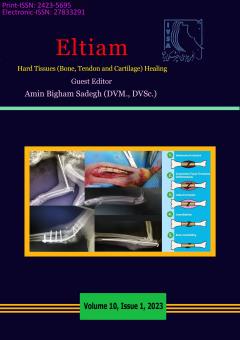The healing process of bone lesions and fractures, effective treatment methods
Subject Areas : Veterinary Soft and Hard Tissue SurgeryHaniyeh yabandeh jahromi 1 * , Abodol hamid Meymandi Parizi 2 , Alireza Shaikhzadeh 3
1 - department of clinical science, faculty of veterinary medicine,Shiraz university,Shiraz, Iran,
2 - Professor of the Department of Clinical Sciences, Faculty of Veterinary Medicine, Shiraz University
3 - Department of clinical science, faculty of veterinary medicine, university of Shiraz, Shiraz, Iran
Keywords: Fracture healing, callus, osteoblast, osteoclast, bone graft, hydroxyapatite,
Abstract :
Fracture repair involves proliferation and differentiation of multiple tissue types in a sequence followed by regeneration. All of these processes may be affected by medications. Some drugs can affect the proliferation of primary callus tissue, others can affect the differentiation of chondrocytes or osteoblasts, formation of capillaries, sensitivity to mechanical input, etc. Therefore, the subject of drugs and fracture repair not only includes pharmacology and orthopedics, but also includes a wide scope. Repair steps after bone damage include: stage 1: (swelling stage), stage 2: (primary bone repair): over the next 4 to 21 days, a callus is formed around the broken bone. In this stage, a substance called collagen gradually replaces the blood clot. Step 3: (secondary bone repair) approximately two weeks after the fracture, cells called osteoblasts start working. These cells cause new bone to fuse and provide minerals needed for bone strength. Step 4: (reconstruction step): in this stage, cells called osteoclasts make the needed changes and adjustments. These cells break down any extra bone that is formed during this healing phase to return the bone shape to its normal status. In current veterinary and also human orthopedics, bone grafts are used for stimulation of fractures healing, accelerate joint fusion and repair of bone defects. Native grafted bone in addition to healing stimulator substances, contains cells that do not stimulate immune reactions and do not transmit infectious diseases. Currently, due to the problems of autologous bone grafting, the desire to use non-autologous bone grafts such as allograft and xenograft has increased. Kinetic hydroxyapatite, tricalcium phosphate and their both combination are among the common materials for bone grafting. Hydroxyapatite works as a scaffold for the growth of bone-forming cells; tarantula cubensis is an extract that is widely used in the treatment of tumors, smallpox, septicemia and toxemic diseases. Also, other materials that are used as substitutes, after being implanted at the site of bone lesions, induce the differentiation of undifferentiated mesenchymal cells present at the site of the lesion into chondrocytes or immature bone cells, and finally, the defects are successfully repaired.
1. Morgan EF, De Giacomo A, Gerstenfeld LC. Overview of Skeletal Repair (Fracture Healing and Its Assessment). Methods in Molecular Biology. 2014;:13-1.
2. Einhorn TA, Gerstenfeld LC. Fracture healing: mechanisms and interventions. Nature Reviews Rheumatology. 2014;11(1):45-4.
3. Ghiasi MS, Chen J, Vaziri A, Rodriguez EK, Nazarian A. Bone fracture healing in mechanobiological modeling: A review of principles and methods. Bone Reports. 2017;6:87-100.
4. Kostenuik P, Mirza FM. Fracture healing physiology and the quest for therapies for delayed healing and nonunion. Journal of Orthopaedic Research. 2016;35(2):213-2.
5. Marsell R, Einhorn TA. The biology of fracture healing. Injury. 2011;42(6):551-5.
6. FROST HM. The Biology of Fracture Healing. Clinical Orthopaedics and Related Research. 1989;2480.
7. Berendsen AD, Olsen BR. Bone development. Bone [Internet]. 2015 Nov;80:14–8.
8. Al-Rashid M, Khan W, Vemulapalli K. Principles of Fracture Fixation in Orthopaedic Trauma Surgery. Journal of Perioperative Practice. 2010 Mar;20(3):113–7.
9.Fragomen AT, Rozbruch SR. The Mechanics of External Fixation. HSS Journal [Internet]. 2006 Dec 21;3(1):13–29.
10. Karpouzos A, Diamantis E, Farmaki P, Savvanis S, Troupis T. Nutritional Aspects of Bone Health and Fracture Healing. Journal of Osteoporosis [Internet]. 2017;2017:1–10.

